Richard and Diane Van Vleck Personal Pages
The Home Habitat |
2010 Nest Box Cam
American Kestrel
Falco sparverius
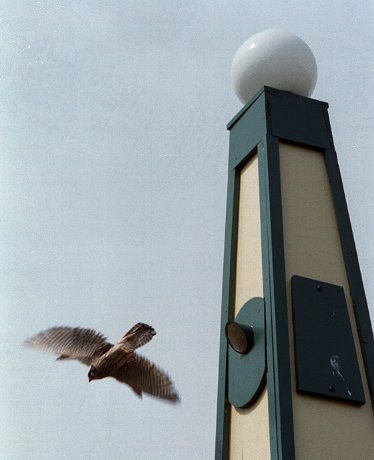
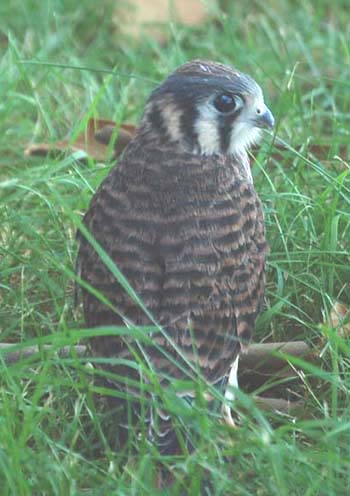
The tower nesting
This year we were very much surprised and privileged to have two pairs of nesting kestrels! As always, one pair used the front yard kestrel tower, successfully fledging 4 young. This nesting was overlooked until I checked the tower nest box on June 6, 2010, to find 4 nestlings. A second pair had been visiting flicker boxes on the barn wall and I wrongly assumed this was the pair that have previously used the tower. This second pair also had 4 nestlings in flicker box "A" of approximately the same age as the tower brood. The female fledgling on the left, photographed on the ground in our front yard, is one of the tower brood. She was being mobbed by various songbirds. The tower fledglings always end up in our front yard and even on the front porch for several days, until they get their bearings and learn to cope with their strange new world. Predators don't have a lot of friends, but they soon gain the confidence to deal with that.
The kestrel nesting in flicker box A on the barn wall
During winter and early spring, our flicker pair continually tried to claim this box, as did multiple pairs of starlings. Many starlings were trapped in this box, often both male and female at the same time, but were quickly replaced by another pair. Box B and then box S were added, and the flickers did manage to successfully fledge a brood in box S. In the meantime, a second kestrel pair comandeered box A from the starlings.
The male kestrel first entered box B on March 30. On April 7, the female entered with him several times. Both kestrels entered box B several times daily for the next five days. On April 12, the female entered box A, and, in subsequent days, it became apparent that the male preferred box B, but the female visited all 3 boxes (A, B, and S). On April 16, she shaped a nest cup in the shavings in box B, but the next day she finally chose box A and laid the first egg. It appears that the male finds the nest sites, but the female makes the final choice. After all, once she begins laying eggs in the nest site of her choice, there isn't much he can do about it.
The Flicker's revenge
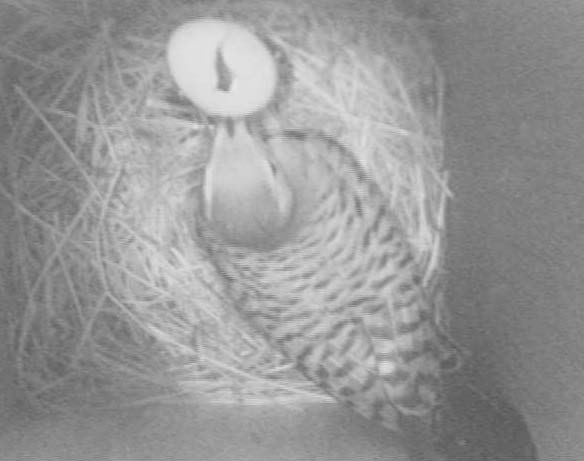
While it was the unrelenting attacks by starlings that drove the flickers from box A to box B to box S, the flickers still periodically visited boxes A and B. On April 19, shortly after the female kestrel laid a second egg in box A, the female flicker entered and removed one egg. After repeatedly trying to pick up the large egg in her beak, she jabbed her lower beak into the egg, enabling her to lift it and pitch it out the entrance hole. She then pecked the second egg and repeatedly pecked the nesting material, seeming to be searching for more eggs. The female kestrel later entered box A and incubated the broken egg. The next day, the female flicker again entered box A for 2 minutes. This was her last vist to the kestrel nest. The two destroyed eggs were replaced with 4 more and the kestrel nesting proceeded unimpeded.
A house wren's great adventure
A house wren entered box A on June 12, amidst 4 nestling kestrels, all somewhat larger than the wren. The wren seemed to not be concerned about the nestlings, but, when the female kestrel entered the box, the wren froze on the nest floor. The kestrel seemed to take a single peck at the wren, perhaps ascertaining if it was stashed prey. When the female kestrel left, the wren looked out the entrance, then returned to the bottom of the box with the 4 kestrel nestlings, apparently unharmed by the kestrel's peck. It remained in the box for 28 minutes. Song birds larger than this wren are frequently caught in mid-air by kestrels, but, I imagine, few kestrels have ever witnessed a sacrificial offering right in their own nest box. What was that wren thinking??

A photo of the kestrel nestlings in box A was taken each day, giving an idea of their development and plumage change. The links below are a sampling of those photos.

Incubation
The male American kestrel develops brood patches and helps incubate. The female always incubated at night. When the male came to relieve the incubating female, he always perched in a nearby maple and called to her. She would then leave the nestbox to join him and was sometimes offered a meadow vole. The male then entered the box to incubate. However, when the female returned to relieve the incubating male, she simply popped into the nest box, at which time the male would promptly leave.
The chart at right records the incubation by each sex after the female first leaves in the morning until she last enters in the evening for overnight incubation.
The chart below represents incubation time in relation to temperature. I didn't log hourly temperatures or use a sensor inside the nest box this year. The female did incubate before the penultimate egg was laid, likely due to low temperatures. This may protect egg viability in cold weather without losing synchronous hatching. This early period is not shown in the charts.
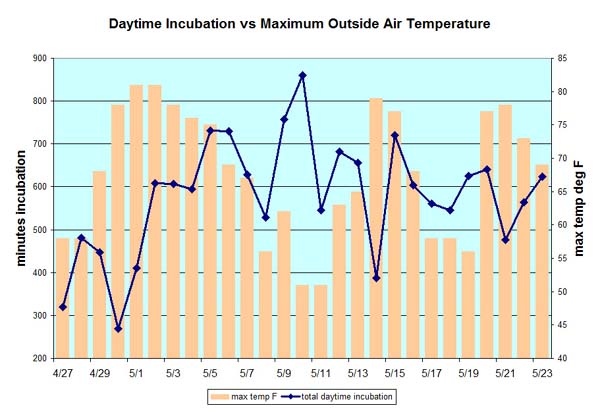
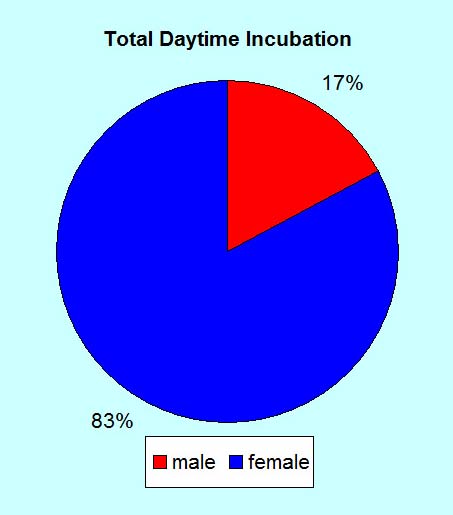
The total daytime contribution to incubation by the male kestrel was 17 percent. However, on occasion, he filled in for long periods of time while the female was absent. He also took several entire days off. Our large vegetable garden is rotated between three plots and this year it was in front of the entrance to nest A. I likely disrupted the kestrel's routine when I was working in the garden. The male is especially shy about returning to the nest when I am present in the garden or even standing at the large window on the bandstand where the video monitor is located. Little does he know that I climb to the third floor daily to photograph the young. But, one thing that doesn't seem to bother any of the species that nest in our barn boxes is the loud music that I play when working in or near the barn. All the nestlings that have hatched in the barn boxes have grown up listening to the likes of Bach, Gordon Lightfoot and Bruce Springsteen, with apparently no ill effect.
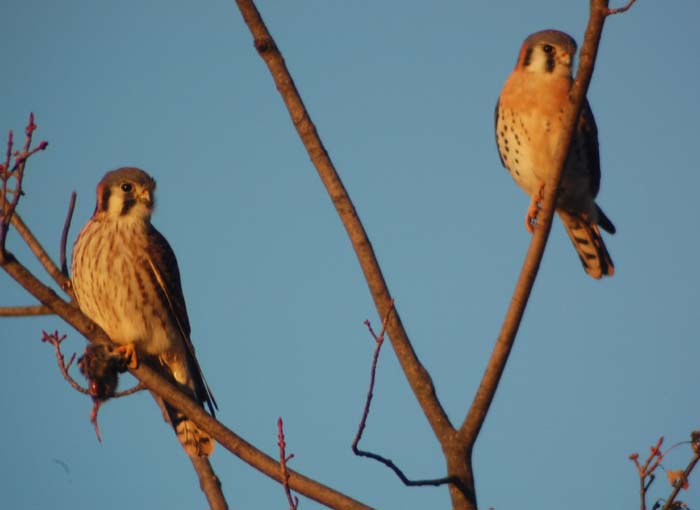
The two adult kestrels (left) were photographed from the bandstand during their last meeting of the evening, before she retired to the nest box. He had passed her a meadow vole, which she was eating on the spot. Cardboad was placed over the large window with just a small hole for the camera lens - in this case, my old Nikon spotting scope.
(below) Serving dinner to 4 hungry nestlings requires skill and patience that only the female seems to have.
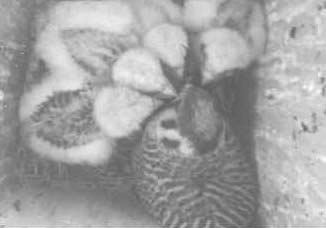
American Artifacts home
email richard@americanartifacts.com
© 2010, American Artifacts and Richard Van Vleck, Taneytown, Maryland.








